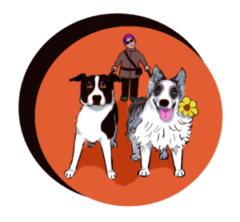This morning I began searching for images and videos for the upcoming HELP for Your Aggressive Dog seminar. Well, now it’s afternoon and I’m far from done. This is both good and bad.
Good because it means there is an abundance of excellent multimedia related to this topic out there to use in a presentation and to anchor some good discussions. And also good because finding good materials shouldn’t be a quick process. Rather, it’s better to be mindful and selective.
Bad because so much of these materials that clearly convey what not to do are out there for public consumption. We live in a time where self determined learning is popular and encouraged. However, many people (including dog trainers) lack the skills to know if the resources are credible and reputable. This point highlights the importance of instructor presence in the learning process. With all the chaff on the Web, it’s not much wonder there are so many troubled canines in this world!
Copyright

I choose to license my own materials using a Creative Commons license. That way when I share handouts, presentation slides, or anything other creations, it is very clear how it can be used. There are several licenses to choose from, and the one I use most often is Attribution 4.0 International (CC-BY). This simply means that all I am asking for is attribution. The materials can be used for commercial purposes, so that includes dog trainers.
I’ve noticed that many people misinterpret Creative Commons licensing to mean giving up control over copyrighted materials. It’s quite the opposite; the license spells everything out, thereby reducing misuse. Using a Creative Commons also means that more people are likely to benefit from the materials. A real bonus is that others might revise and improve the work. What’s not to like about that?
So how does this work if I am integrating media created by somebody else? My starting point is always the Creative Commons search page. Since I’m using a CC-BY license, I look first for photos and videos that carry the same license. That keeps is it simple, although I can always use the “unless otherwise stated” phrase if I end up using works licensed with more conditions.
Photos
Generally photos are easy to find. I have the most success with Flickr. For example, when looking for images to use for the section on canine body language, a search on ‘dogs’ turned up over 840,000 images, including 45 of my own uploads. I later narrowed down my search to ‘aggressive dogs’, ‘shy dogs’, ‘guilty dogs’ and so on. It’s amazing how many people interpret a dog that is terrified of what the handler will do next as “guilt” (another topic).
Once I find a photo I want to use I download it, then collect 3 things:
- URL (use the ‘share’ option to get a shortened URL)
- Name of photographer
- License (even though I search on CC-BY materials, I still need to double check the license assigned to the work)
 Videos
Videos
While there are many places to upload videos, I’ve noticed that most dog trainers use YouTube. Fortunately, it’s possible to search just on those videos assigned a creative commons license. This is where I spent the most time. My goodness there are a lot of videos! It can be a time-consuming process.
Just as with photos, I collect the basic information I need to use the media:
- URL (use the ‘share’ option to grab the link)
- Name of person who uploaded the video
- Check the license.
Sometimes the individual managing the YouTube channel or individual uploads does not adjust the settings to allow for downloading. Logically, if you are using a CC-BY license, you should let people export or download since the whole point is to be able to use and modify the work. If the proper settings aren’t switched on, I use an online service called SaveFrom.net to handle the downloads. It’s free and as easy as pasting in the video URL.
 YouTube also has a video editing service that allows you to search and remix Creative Commons licensed works.
YouTube also has a video editing service that allows you to search and remix Creative Commons licensed works.
Note that the standard YouTube licence is effectively ‘All Rights Reserved’. This means you can view the video, but you can’t download or edit it without permission. I’m sure many people use this default license without even thinking about it. With the default license, If the author enables embedding, then you can integrate the video into a web page, but you need to clearly state it is an ‘all rights reserve’ license if your publication uses a more flexible license.
Organizing all the stuff
I will be using PowerPoint and my own laptop computer for the seminar. That way I don’t need to rely on internet access to access websites and play videos. Using PowerPoint or Keynote (Mac) is actually a really convenient way to assemble the materials. Just add media and use the notes section to keep track of attributions and points you want to make about each slide. Even if the final product is published online, PowerPoint is a convenient way to keep everything organized during the planning phase.

One thought on “Assembling the materials”